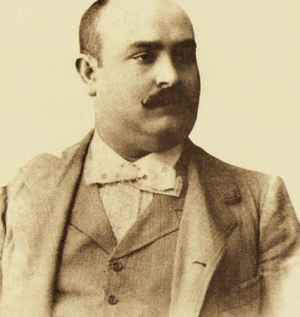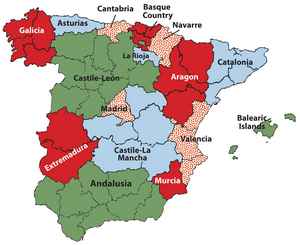


Antonio Chacon
Source: Fernando Barros
Launching the flamenco portion of the HMR Project is Antonio Chacon. Flamenco is the romantic folk music of Spain with form distinctive in and of itself. It had its origins around 1850 with the emergence of the cafe cantata, arising out of Andalusia, the southernmost region of Spain:

Andalusia Birthplace of Flamenco
Source: lardbucket
The term "flamenco" had come into usage in the latter 18th century. Uncertain in origin, it is possibly derived from "gypsy," 'fire," "flame" and/or "fellah mengu," meaning "expelled peasant" in reference to the Moors. Flamenco's heydays were around the turn of the century before recording could disseminate it about the globe. With an emphasis on maintaining integrity to tradition, it has since developed into numerous palos (styles). Initially a dance, voice was added, then guitar in a supportive role. Percussion is supplied through dance consisting of clapping, knocking and stamping. This is flamenco's original element to which it is distinctly bound, embroidery by guitar virtuosi developing much later.
The flamenco guitar is constructed differently from the classical guitar, having developed differently to its peculiar usage, such as accompaniment to stamping baile flamenco (flamenco dance) or the cante flamenco (flamenco singing). Among the first to emphasize guitar in flamenco is Ramon Montoya who began recording in 1923. The first recordings made in Spain are thought as of late 1899 by Fred Gaisberg, an American recording engineer said to have produced 128 tracks in Madrid. There exists a discography published in 1900 listing among its titles, 'Malaguenas' by Sr. Garcia, as well as several by Mochuelo: 'Soleares', 'Guajiras' and Malaguenas' among them. Those were among 64 tracks played at a public gramophone demonstration costing 10 centimos to attend. A magazine dated 1901 mentions cylinder recordings (invented 1889) by Antonio Chacón. A quantity were made by El Mochuelo in 1901 as well, together with a host of others having recorded by then. The first recorded discs appeared in 1901 or '02, one-sided and slightly over seven inches in diameter. Among Spanish musicians found on such are El Canario Chico, El Mochuelo, La Rubia, Niño de Cabra, Niño de la Hera and Sebastian Scottta (sic).
As flamenco is necessarily unique to itself, as well as bound to tradition, it's less readily given to fusing w other genres. If Latin rhythms on the other side of the Atlantic in the Caribbean or South America eagerly embraced collaboration with jazz musicians in the States, flamenco has resisted synthesis with other forms. Remarkable results in classical or jazz environments have nevertheless occurred, such as Camarón de la Isla and Paco de Lucía with John McLaughlin.
Antonio Chacon was an alto vocalist who is thought to have recorded on cylinder by 1901, those titles undetermined. Chacon avoided recording for much of his earlier career, presumably finding it pointless due to their poor audio quality, as did many other musicians of the period. Born in 1869 in Jerez de la Frontera, Cadiz, Chacon is a leading figure in the flamenco orthodoxy. He began performing publicly in 1884, touring about Andalusia. Donald Clarke has him recording in 1909, 1913, 1925 and 1928. Among the better known guitarists with whom he performed were Ramon Montoya, later Sabicas. The chronological order of the 1928 examples below isn't determined, thus listed alphabetically. Each track is an individual style of flamenco, beginning with a malaguena, that is, native to Malaga on the Mediterranean coast of southern Spain about 85 miles northeast of Gibralter:
'Si preguntan por quién doblan' ('If They Ask Who They Bend For')
Antonio Chacon Guitar: Ramon Montoya 1925
'Los Campanilleros' is a siguiriya developed from out the tona, an original flamenco approach thought to have its origins in the region between Seville and Cadiz on the southwest coast of Spain about 75 miles northwest of Gibralter:
'Los Campanilleros' Antonio Chacon Guitar: Perico el del Lunar 1928
'Composition: Niño Ricardo
Native to Granada in southern Spain about 75 miles northeast Malaga is the grenadina:
'Rosa si yo no te cogí' ('Pink If I Didn't Catch You')
Antonio Chacon Guitar: Perico el del Lunar 1928
Chacon died in 1929 in Madrid seven years prior to the Spanish Civil War.
Sources & References: Antonio Chacon:
VF History (notes)
Catalogs:
Compilations:
Antonio Chacon (1913 & 1937 on OK Records CD-2490)
Cátedra Del Cante (1909-1928 on Mivox CDMIV-016-S)
In Soundtracks:
Further Reading:
Sources & References: Flamenco:
Flamenco Composition and Ownership:
Flamenco Culture:
Flamenco Dance:
Flamenco Fusions:
Flamenco Guitar:
Flamenco History (University of California-San Diego):
D.E. Pohren:
John Moore (Professor of Linguistics at UCSD):
Flamenco Musicians:
Flamenco Rhythms:
Flamenco Terms:
The Malagueña (flamenco style derived of the fandango):
The Seguiriya (form of the cante jondo):
Further reading:
Classical Main Menu Modern Recording
hmrproject (at) aol (dot) com